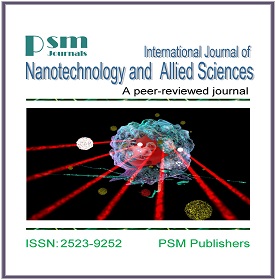Gold Nanoparticles (GNPs): Synthesis, Properties and Conjugation Methods
Keywords:
Nanoparticles, immunoassay, bioconjugationAbstract
EDITORIAL
Nanoparticles are defined as particles between 1 and 1000 nm that have a range of unique properties. Nanoparticles have attracted much attention in recent years for their potential applications in biomedical research including drug and gen delivery (Guo et al., 2010), bioimaging (Tiwari et al., 2011), vaccine development (Niikura et al., 2013), biosensors, and therapies (Nicol et al., 2015). The application of nanomaterials gives opportunity to provide revolutionary changes in sensitivity, specificity and rapidity of detection as well multiplexing capability, simple operation, miniaturization and low cost of such devices. Colloidal gold is a solution or colloidal suspension of nanoparticles of gold in a fluid, usually water with particles less than 100 nm. Recently it’s used in chemistry, medicine, technology, and biology. In the age of high technology with rapid growth of gold nanoparticle, immunoassay developed a potential in nano scale quantification with high and precisions accuracy. In the modern era of science and technology rapid development of immunochrmatographic assay based on colloidal gold has shown significant changes for the past half a century. Gold nanoparticles have been often studied due to their unique surface, chemical inertness, high electron density, and strong optical absorption. In recent decades, gold nanoparticles have been applied in genomics (Guo et al., 2010), clinical chemistry (Saha et al., 2012), vaccine development (Pokharkar et al., 2011), immunoassay (Hall et al., 2011), biosensors (Zayats et al.,2005), diagnosis, and microorganisms control (Pissuwan et al., 2010), cancer-cell imaging, and drug delivery (Pivodova et al., 2015). Physical and chemical interactions are used for attaching antibodies and other molecules to GNPs surface. Various factors influence the physical interaction between antibodies and gold nanoparticles including ionic attraction between the negatively charged gold and the positively charged antibody; hydrophobic attraction between the antibody and the gold surface; and dative binding between the gold conducting electrons and amino acid sulfur atoms of the antibody. Antibodies and nanoparticle surface are bonded chemically through chemisorption via thiol derivatives; through bifunctional linkers, and through the use of adapter molecules.
For conjugation of antibodies to the gold particles, both covalent and non-covalent immobilization modes have been used (Kumar et al., 2008). The antibodies or other functionalized groups are non specifically adsorbed onto gold nanoparticles while still keeping the nanoparticles negatively charged, providing stability in colloidal solution. Colloidal gold nanoparticle has shown involvement, of enormous electrical, optical, magnetic, and chemical properties. The outcome of these properties has been determined based on parameters including size, shape, and structure. The peculiar characteristics of these nanoparticles are that they qualify with unlimited potential for application in the fields of medicine, biotechnology, and within nano scale application capacities. Understanding the bioconjugation, chemistry of functionalization of GNPs and detec-tion system of conjugation, opens novel opportunities for their use in biomedicine.
CONFLICT OF INTEREST
The authors declare that no competing interests exist.
Citation:
Iqbal, M.N, Ashraf, A., Wang, S., 2018. Gold Nanoparticles (GNPs): Synthesis, Properties and Conjugation Methods. Int. J. Nanotechnol. Allied Sci., 2(1): 1-2.
REFERENCES
Guo, S., Huang, Y., Jiang, Q., Sun, Y., Deng, L., Liang, Z. et al., 2010. Enhanced gene delivery and siRNA silencing by gold nanoparticles coated with charge-reversal polyelectrolyte, ACS Nano., 4(9): 5505-5511.
Hall, W.P., Ngatia, S.N., Van Duyne, R.P., 2011. LSPR biosensor signal enhancement using nanoparticle-antibody conjugates. J. Phys. Chem., C 115(5): 1410-1414.
Kumar, S., Aaron, J., Sokolov, K., 2008. Directional conjugation of antibodies to nanoparticles for synthesis of multiplexed optical contrast agents with both delivery and targeting moieties, Nat. Protoc., 3(2): 314–320.
Nicol, J.R., Dixon, D., Coulter, J.A., 2015. Gold nanoparticle surface functionalization: a neces-sary requirement in the development of novel nanotherapeutics. Nanomed. Nanotechnol. Biol. Med., 10(8): 1315-1326.
Niikura, K., Matsunaga, T., Suzuki, T., Kobayashi, S., Yamaguchi, H., Orba, Y. et al., 2013. Gold nanoparticles as a vaccine platform: influence of size and shape on immunological responses in vitro and in vivo, ACS Nano., 7(5): 3926-3938.
Pissuwan, D., Cortie, C.H., Valenzuela, S.M., Cortie, M.B., 2010. Functionalised gold nanopar-ticles for controlling pathogenic bacteria, Trends Biotechnol., 28(4): 207-213.
Pivodova, V., Frankova, J., Galandakova, A., Ulrichova, J., 2015. In Vitro AuNPs’ Cytotoxicity and Their Effect on Wound Healing.
Pokharkar, V., Bhumkar, D., Suresh, K., Shinde, Y., Gairola, S., Jadhav, S., 2011. Gold nanopar-ticles as a potential carrier for transmucosal vaccine delivery, J. Biomed. Nanotechnol., 7(1): 57-59.
Saha, K., Agasti, S.S., Kim, C., Li, X., Rotello, V.M., 2012. Gold nanoparticles in chemical and bi-ological sensing, Chem. Rev., 112(5): 2739-2779.
Tiwari, P.M., Vig, K., Dennis, V.A., Singh, S.R., 2011. Functionalized gold nanoparticles and their biomedical applications, Nanomaterials, 1(1): 31-63.
Zayats, M., Baron, R., Popov, I., Willner, I., 2005. Biocatalytic growth of Au nanoparticles: from mechanistic aspects to biosensors design. Nano Lett., 5(1): 21-25.







